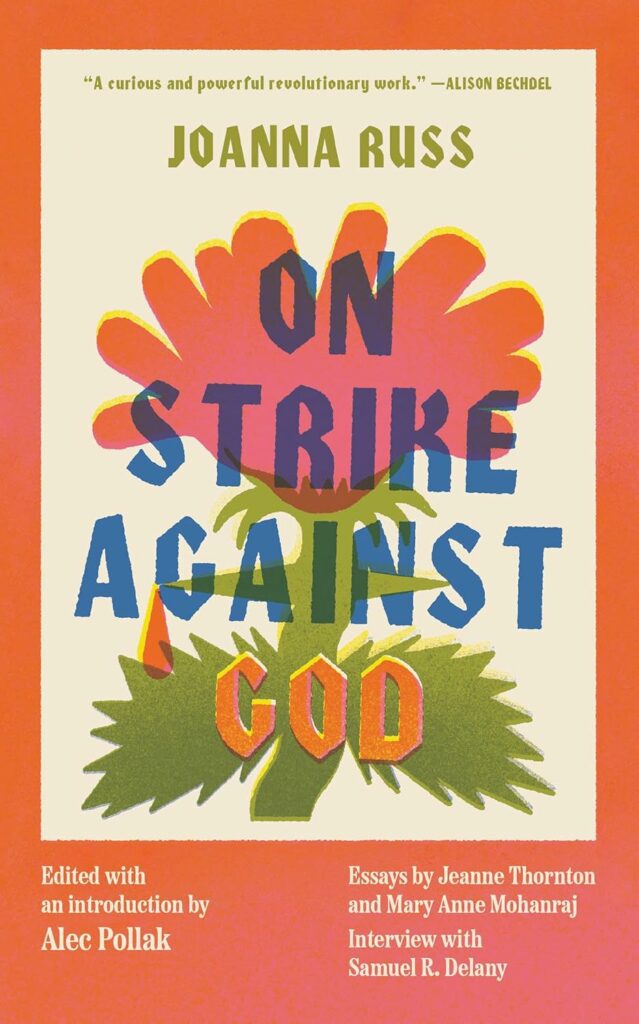
Is heterosexuality a choice? A new edition of Joanna Russ’s 1980 novel On Strike Against God asks us to reckon with this and other questions posed by an earlier generation of feminists. Heterosexuality warps the thirty-eight-year-old protagonist Esther’s life—until she figures out how to shake it off. Esther describes her engagements with heterosexuality as a kind of pathology. Sex with her ex-husband was painful yet bland. She became “sexually dead,” suffering physical symptoms. An affair with Jean, a graduate student and Esther’s first female lover, helps cure her. Yet Esther is clear that this is not merely her personal condition, and her anti-heteropatriarchy convictions sharpen.
On Strike Against God epitomizes a type of feminism, associated with the second wave, in which straightness is not a sexual preference, but instead a political force that consolidates male power at the expense of women. Some feminists, the much-maligned “political lesbians,” saw feminism and lesbianism as inextricable. Joanna Russ (1937–2011) herself was a lesbian and a feminist, though her commitment to “political lesbianism” as such is unclear. Russ was like Esther: a professor who came out in her late 30s. Her most famous work, The Female Man (1975), a sci-fi novel, is an overt lesbian feminist manifesto. On Strike is Russ’s only realist novel. But despite—or perhaps because of—Esther’s initial uncertainty about her political convictions, On Strike is a successful polemic against heterosexuality.
After describing sex with her ex-husband, Esther addresses an assumed-heterosexual woman reader: “You aren’t good at it [heterosexuality] . . . you don’t like it . . . you’re at sea and unhappy.” This statement might offend some adherents of modern gender inclusivity and sex positivity. It’s also plainly mean, as Esther can be. She’s only lightly sympathetic to the daily travails of straight women, bristling when they won’t consider systemic forces behind their individual dissatisfaction. Esther comes to believe straightness and feminism are incompatible. Her universalizing of what’s best for all women and anger at those who don’t agree would likely not fly in today’s feminist subculture.
That said, Esther is neither incorrect, per se, nor unpleasant to read. She cares deeply about both feminism and lesbianism. The novel recalls Virginia Woolf’s Mrs. Dalloway (1925) in its portrait of a woman whose capacity for love and joy are stymied by heterosexuality. In fact, Esther and Jean discuss Woolf’s writing passionately. Later, Esther ponders how the potential of older women writers was undermined by the expectations of marriage and the heteropatriarchal family. She demands through gasps and sobs that others should care as deeply as she does about these women’s fates.
Old drafts and letters between Russ and the poet Marilyn Hacker, included in this edition of the novel by editor Alec Pollak, reveal that On Strike originally ended with Esther practicing shooting a rifle, threatening to kill male enemies who stand in her way. Hacker successfully encouraged Russ to make “this one . . . be for . . . women,” instead. Russ balances Esther’s polemics with moments of gentle care toward women. There’s an ethics behind her militancy.

Pollak, an academic and critic writing a biography of Russ, diagnoses the way this militancy of the 1970s women’s movement gets maligned. In her introduction to On Strike, Pollak describes the feedback she received on her book proposal: “I encountered the same feedback again and again: ‘I love it, but it’s so second wave.’ . . . Second wave feminism has become a kind of shorthand for ‘bad’ feminism.” Pollak notes that “second wave” is now often used metonymically to denote controversial feminisms: on the one hand, it evokes a feminism focused on white women’s career aspirations, like Betty Friedan’s The Feminine Mystique (1963); on the other, it evokes a feminism that rejects any ties to men, as did some political lesbians.
Pollak defends the second wave. It is futile, she argues, to reduce such a diverse, intellectually productive period to mere shorthand for too-exclusive or too-radical feminisms. She also takes note of recent critical reconsiderations of second wave luminaries. She cites Johanna Fateman, who calls the second wave writer Andrea Dworkin a “revelation.” Encountering Dworkin’s writing allowed a young Fateman, then a nascent riot grrrl, “to see patriarchy with the skin peeled back,” despite what Pollak calls Dworkin’s purported “anti-sex activism.” Similarly, Sophie Lewis—author of such polemics as Full Surrogacy Now: Feminism Against Family (2019)—has recouped Shulamith Firestone, whose The Dialectic of Sex (1970), contrasting with modern anti-essentialism, argues that the locus of women’s oppression is biological reproduction. Both Fateman and Lewis also defend their subjects from the kind of personal critiques contemporary readers might lob at Esther: that they were too self-absorbed, or too mean.
And yet, at times, contemporary writers like Fateman and Lewis still disavow their second wave subjects as problematic. Pollak notes that this hedging invokes the idea of “‘reasonable response’ to lived experience.” Today’s feminists look for the “links between the [second wave] movement’s incendiary rhetorics and the experiences . . . that gave rise to them.” As someone who came of age during the 2010s, a period in which loudly denouncing the second wave became almost a requirement of feminist rhetoric, I found this point resonant. For instance, I’ve heard peers of mine say that Firestone was being essentialist or silly when she wrote that artificial wombs were key to women’s liberation, but that her argument was a “reasonable response” to the stresses of midcentury heteropatriarchy. This defense infantilizes Firestone, framing her writing as a kind of tantrum.
Instead, Pollak celebrates radical feminist polemics that universalize all women—the kinds that Esther uses and that draw criticism of Dworkin, Firestone, and others. To combat patriarchy and its degradation of all women, feminism requires radical ideas about what all women are, or should be, instead. Such polemics never hold up to scrutiny and can always be modified to be more inclusive. Esther, instead of commenting on the “rotten lives” of straight women, could pause and think about all the reasons why this universalizing statement might be untrue or harmful. Nonetheless, Pollak argues that she must be polemical to generate an affective response, one that can raise our consciousnesses and make us “secure enough” to think complexly. She also notes that adding endless caveats to a feminist polemic “can veer into . . . gendered self-erasure,” pressuring women to, as ever, soften and apologize.
Pollak’s argument is particularly compelling considering the timeline of the novel’s publication: Russ began writing On Strike in 1973, but it was not released until 1980. As documented in Susan Faludi’s Backlash (1991), the 1980s saw a fierce political retaliation against the women’s movement, beginning with the defeat of the Equal Rights Amendment, as well as a cultural backlash, most apparent in the pervasive media messaging that blamed all kinds of perceived social problems—including women’s loneliness and the decline of the nuclear family—on feminism.
Parallels to today are clear. We are facing another backlash, most evident in the Dobbs decision. But even among purported friends of feminism I see a new ironic detachment. Whenever I open social media, for instance, I see posts playing on post-COVID anti-work sentiment by blaming feminism for forcing women to work, or adult women joking about being “just a girl” or doing “girl math.” These posts may be in jest, but they nonetheless point to a rising feminist apathy. The culprits are likely not anti-feminist at all, but, on the other hand, they don’t earnestly care about feminism in the way that, say, Esther does. But my fear is that we cannot afford to make such jokes unless we are all in agreement that no serious person would support patriarchy. Abortion bans, for instance, suggest that we are not. And jokes aside, here is a more material indicator that feminist fervor is fading: advocates report that donations to abortion funds—which surged after Dobbs—have all but disappeared in recent months.
The growing detachment that women feel toward feminism is one part of the current backlash to what I’ll call the “fourth wave” of the 2010s. In fact, Esther’s earnestness reminds me of that period, when caring about feminism was cool. Anyone typing #MeToo could participate in the movement. Celebrities from Beyoncé to Emma Watson were suddenly vocal feminists. Not all popular feminism was sound, but achievements of the fourth wave cannot be denied: campus anti-rape activism, for instance, resulted in serious conversations about consent and new curriculum and protocols for addressing assault on campus. But as the earnestness of the fourth wave fades, we risk losing its achievements, too.
Esther’s earnestness reminds me of the 2010s, when caring about feminism was cool.
What fomented the current backlash? For one, it’s harder to care about abortion funds or sexist jokes in the midst of impending climate change and fascist coups. Also, the pop-feminism of hashtags and celebrities can make feminism feel shallow and unserious. Nonetheless, Dobbs shows us the hazards of apathy.
Esther’s unironic commitment to the cause is a necessary counteraction to 2020s detachment. She’s responsible for her feminism. Her method—political lesbianism—is certainly not the only one. Nonetheless, by rendering straightness not as an institution too big to fail, but as a system individuals can opt out of, Esther assures us we can do something about patriarchy. It isn’t easy—she loses friends, and her first lesbian sex is awkward—but this change is worthwhile. It “challenges what you men are going to inflict on us,” says Esther.
What happens to nuance, then? On Strike shows us that complexity is possible without endless caveats. What if we could see the validity of multiple extreme viewpoints at once? Stevie, Esther’s gay male friend, blows up on learning about her later-in-life lesbianism: “Oppression in your happy, sheltered little life?” he scoffs. “Try being beaten up by the police.” In fact, Stevie is a lot like Esther. He’s unnuanced and wrong, but also very right, and perhaps able to light a fire for readers like him. Stevie and Esther care, and they don’t apologize for how they feel, even if it’s offensive. Let’s return to this kind of polemical politics. Let’s be like Esther: re-embrace feminism as something to care about and do.

